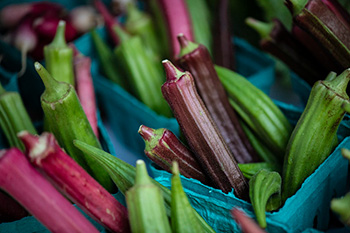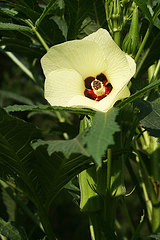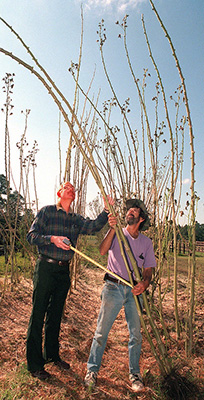How To Grow Okra In Florida
Okra

A staple of Southern cuisine, okra came to the Americas from Western Africa. Information technology is traditionally used to thicken soups or gumbos, or sometimes merely served up fried. Florida gardeners appreciate okra's heat tolerance and long growing season.
Characteristics
Culinarily, okra (Abelmoschus esculentus) is considered a vegetable. Botanically speaking, nonetheless, what nosotros swallow its edible fruit pod. And for anyone noticing that the okra bloom looks similar a hibiscus flower, splendid detective work! Okra is in the taxonomic group Malavaceae, the hibiscus family. Other family relatives include roselle and cotton wool.
Like hibiscus, okra has wide leaves and grows to the size of a medium shrub. Plant heights vary by cultivar and pruning practices. Virtually fall within the 3-6 human foot range but check your seed source for more than data. When the crop gets too tall to selection, you can clear the rows and plant again.
Okra varieties come in a kaleidoscope of colors. For Florida, look for 'Annie Oakley 2', 'Cajun Delight', 'Emerald', 'Clemson Spineless', and 'North and South'. 'Cow's Horn' and 'Blondy' are also pop. Okra is increasingly valued as an ornamental, too. Varieties like 'Alabama Ruby-red' and 'Burgundy' offer assuming, cherry-red foliage and striking flowers.

Planting and Care
Okra is well suited for Florida'due south hot, humid summers. Institute this warm-flavor vegetable when evening temperatures are in the mid-fifties. Due south Florida can grow okra nigh twelvemonth-round. In general, peak months stretch from March to Nov. Choose a sunny location with well-drained soil. Programme to soak the seeds in h2o for six hours prior to planting, too. This will heave germination.
Temperature and soil moisture are the limiting factors for okra's growth rate. Okra grows all-time when the soil is to a higher place 65°F and is well watered. A balanced, slow-release fertilizer is a good choice for okra in the home vegetable garden. Decision-making weeds ahead of planting is critical, as well. Afterwards, okra'south mature canopy shades the planting area and helps reduce weed competition.
From the planting date to harvest, okra is a fast-growing and high yield crop. Depending on the cultivar, yous could be harvesting 50 to lxx days after planting. When okra starts to bloom, harvest will happen within a few days. Pick pods when they accomplish about two to three inches in length.
It's a good thought to harvest okra early and often. The pods will exist too tough to swallow if they mature on the plant. At the height of harvest season, you may demand to pick daily. If your pods exercise stay on the plant likewise long, consider using them in flower arrangements. Okra pods make an eye-catching display.

Okra plants at harvest fourth dimension (USDA)
While harvesting, be conscientious of the fine hairs on the stalk, leaves, and fruit. Wearing long sleeves and rubber gloves will reduce the skin irritation. You may desire to utilise shears, likewise, to cut through the gristly stems.
Okra suffers impairment from a wide range of insect and arachnid pests. Aphids, cucumber beetles, melon thrips, southern light-green stink bug, whiteflies, caterpillars, and spider mites are common only controllable. Sentinel early and practice integrated pest management. Okra is too susceptible to damage from root-knot nematodes. Encompass crops similar velvetbean (Mucuna pruriens) and sunn hemp (Crotalaria juncea) can help suppress nematodes when growing okra. Crop rotation is especially helpful in keeping nematode populations manageable.
For more data virtually okra contact your canton Extension function.

Larry Forshee, right, was hoping to set a record with his okra plants that topped out at 17 feet, 5 inches, but cooler weather dashed his hopes. Photography by Milt Putnam, UF/IFAS.
Our thank you to Lisa Hickey, UF/IFAS Sustainable Ag & Food Systems Extension Amanuensis for Manatee Canton Extension, for the contents of this article.
Also on Gardening Solutions
- Rut-tolerant Vegetables
- Hibiscus
- Red Leafy Vegetables
- Roselle
- Vegetable Gardening by Season
More than from UF/IFAS
- Add together Some Cajun to Your Garden with 'Jambalya' Okra--Gardening in the Panhandle
- Florida Institute ID: Okra
- Florida Vegetable Gardening Guide
- Oh to Okra, A Summertime Time Vegetable! UF/IFAS Extension Manatee County
- Okra Production in Miami-Dade Canton, Florida
- Vegetable Production Handbook: Chapter 10. Pocket-sized Vegetable Crop Production
Source: https://gardeningsolutions.ifas.ufl.edu/plants/edibles/vegetables/okra.html

0 Response to "How To Grow Okra In Florida"
Post a Comment